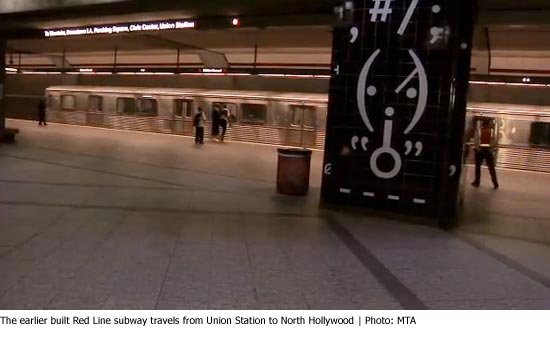7 things you should know about the Westside Subway
October 31, 2009
With the Metro board’s recent approval of long range transportation projects for the region, the Westside Subway extension is embarking on an important new stage in its journey. With Santa Monica envisioned as the line’s ultimate destination, there is currently $4.1 billion in local funding, mostly from Measure R, to get it as far as Westwood. Federal dollars will be essential to finish the job.
Some critics of the proposed line argue that it will take too long to build, divert resources from other parts of the region and tunnel through some geological challenges. But proponents, including Supervisor Zev Yaroslavsky, an MTA board member, say the subway’s projected ridership success makes it the best bet for getting federal dollars, particularly since Measure R already is funding projects such as Expo Phase II, the Gold Line/Foothill extension and the Crenshaw Transit Corridor.
Key decisions are still to come on design and technical matters; community meetings are taking place to help determine the placement of stations, and there’s a new video to promote the project (thanks to Steve Hymon for flagging this at Metro’s new blog, The Source.)
So even though the first phase of the project—to Fairfax–won’t be completed until 2019, it’s not too early to know what’s driving the train.
It will go where jobs are.
The Westside has hundreds of thousands of jobs in a relatively concentrated area—currently 429,000 of them, according to the latest mid-year forecast by the Los Angeles County Economic Development Corp.– and commuters who live in outlying areas where housing is more affordable will be able to take advantage of them. That will be a boon to area business owners who’ve long complained about difficulties in hiring and retaining workers frustrated with time-consuming commutes, says Jack Kyser of the Kyser Center for Economic Research, one of the forecast’s authors. A bonus: those jobs are the highest-paying in the county—averaging $66,497 a year. The area also is home to UCLA, the 7th largest employer in the region, with more than 28,000 faculty and staff members.
It will create jobs.
Thousands of jobs will be created. As a rule of thumb, the building trades industry estimates 6,000 construction- and construction-related jobs per $1 billion invested in a project. The exact number of jobs in the long run, however, is hard to predict because those initially hired could stay with the project for multiple years, thus driving down the overall job count.
It will benefit commuters throughout the county.
Metro estimates that 64% of the line’s benefits—a federal formula measuring ridership and time saved–would go to those outside the Westside, with the greatest benefit (22 percent) accruing to the San Gabriel Valley. Metro research shows that more than 310,000 people travel into the Westside from across the region each morning, while 137,000 others leave it and 88,000 travel within it. Meanwhile, UCLA, California’s largest university, is a major area-wide draw with nearly 38,000 students, and the subway extension also has the potential of boosting cross-town access to a variety of major cultural venues, from Disney Hall and the Museum of Contemporary Art (MOCA) to the Los Angeles County Museum of Art and Royce Hall.
It will save thousands of hours in commuting time.
A hypothetical twice-a-day commuter from Koreatown to Westwood would get back the equivalent of eight days in saved commuting time each year by using the subway, according to Metro estimates. Someone commuting from Pasadena would save even more time–12 days a year. To put it another way, that Pasadena commuter currently spending 82 minutes to get from Pasadena to Westwood on public transportation would be able to make the one-way trip in just 50 minutes. “It actually shrinks the city, in a sense,” says David Karwaski, planning and policy manager in UCLA’s Transportation Services Department.
It will help LA to get a greater share of federal transit dollars.
Putting this project in the pipeline sets the stage for Los Angeles to get an allotment that’s more like the New York/New Jersey behemoth, shown in this Metro graphic representing 2010 federal funding for new transit starts. A far more robust showing is possible in the future now that the board has adopted its long range projects priority list. Move over, New York and Salt Lake City. Hello, Los Angeles.
It will help relieve overcrowding on the region’s busiest bus corridor, Wilshire Boulevard.
The Wilshire corridor is the most heavily used bus corridor in the County of Los Angeles, with some 70,000 boardings every weekday from downtown to Santa Monica. With tens of thousands of office workers pouring into the area each day, and bumper-to-bumper traffic at peak hours not only on Wilshire but on the Santa Monica Freeway, the project provides a new option for bus riders while also easing the overall traffic crunch.
It beats taking the 10.
Need we say more?














 405 bridge work causes a stink
405 bridge work causes a stink

